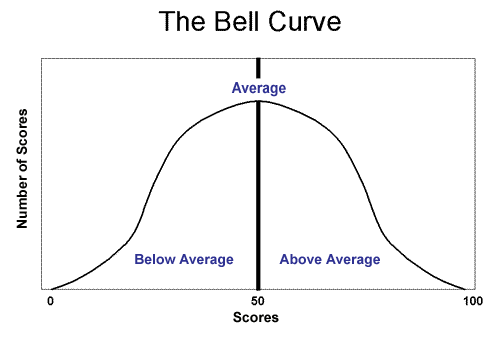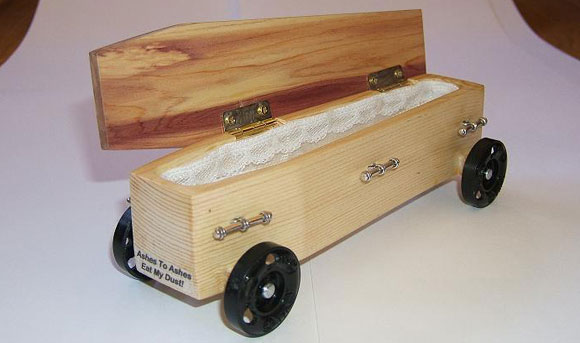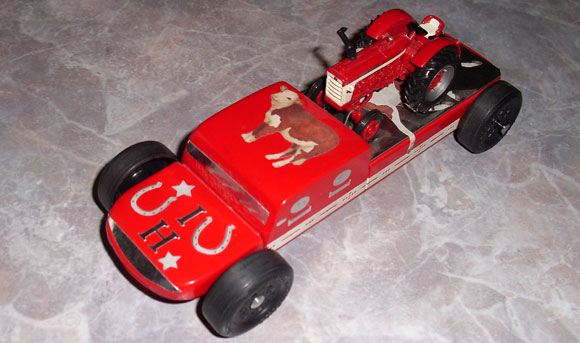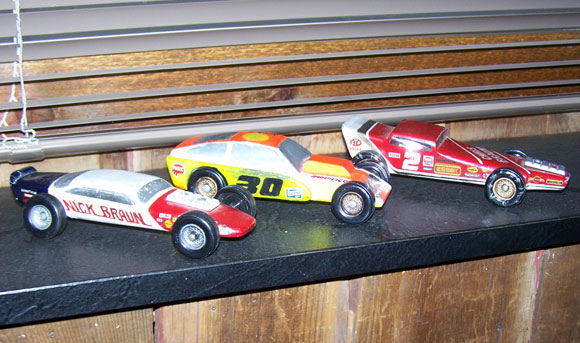– Feature Article – Grading on the curve
– Car Showcase
– Memory – New Track Record
– Q&A
Grading On The Curve
Does that phrase bring back memories of elementary and high school? For most people, the grading curve brings back bad memories.As you recall, the grading curve was used to assign letter grades. Those on the right side of the curve received A’s and B’s, those on the left side received D’s and F’s, while those in the middle received C’s. In most classes, there were a few “brains” that distorted the curve for everyone else, leaving us with a lower GPA than we would have liked.
But the Bell Curve itself is not inherently bad. In many data sets, the numbers tend to arrange themselves in a bell-shaped curve. There are always the low and high oddball numbers, and the much larger group of average numbers. In pinewood derby racing, this is often seen. There are a few cars that are very fast, a few cars that are very slow, and the rest are arranged in the middle.
If we apply the Bell Curve to pinewood derby racing, we might arrive at something like this:
Pinewood Derby Grade
- A – Trophy winner
B – Competitive
C – Middle of the pack
D – Crossed the finish line, but generally last
F – Didn’t cross the finish line
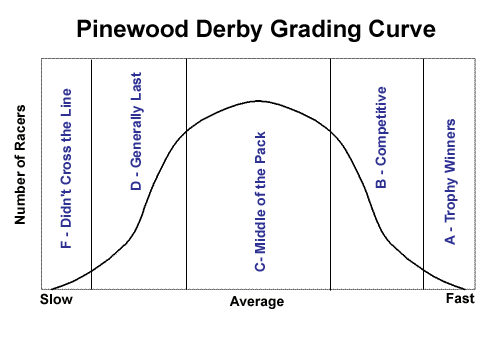
To help with the tutoring aspect of this, I’d like to share some ways that you can improve your pinewood derby letter grade. The tips are cumulative, so if you want to move from an F to a B, you will need to implement all of the F to D, D to C and C to B steps. I have not provided the implementation details; most of them are available in past newsletters, or in our speed tip booklet “Speed to the Finish“.
From F To D
Cars that don’t cross the finish line generally suffer from one of the following problems:
- The car is not lubricated, or is lubricated with a substance that is detrimental (Powdered Teflon, grease, soap, etc). Resolution: Lubricate with graphite
- The wheels are restricted from spinning due to paint or glue. Resolution: Paint before mounting the wheels, and make sure the paint is dry. Be careful with glue; I recommend against using Super Glue to attach the axles, as this type of glue commonly locks up wheels.
- A wheel gap is too small, resulting in a wheel that doesn’t spin freely. Resolution: Set the wheel to car body gap with a gap gauge (or a credit card).
- The car is much too light weight. Resolution: Make sure to add weight to your car.
From D To C
Once your car crosses the finish line, there are several more steps that will move your car up to the middle of the pack:
- The car is shy of five ounces (or the maximum weight for your race). Resolution: Design the car so that you can readily add weight so that the car weighs five ounces.
- The axles have flaws that prevent smooth spinning. Resolution: Remove axle flaws with a small file, and then polish the axles.
- The tread and inside edge of the wheels are not smooth. Resolution: Lightly sanding the running surfaces with a fine grit, wet sandpaper.
- The wheels are not mounted accurately. Resolution: Verify that the axle slots are square before building the car, and then mount the axles squarely in to the slots.
From C To B
Now that your car is starting to perform, let’s step it up a notch. Here are some tips to help you run with the big boys:
- The wheels are lubricated, but not thoroughly, and not with a high- quality lube. Resolution: Before mounting the wheels and axles on the car, thoroughly lubricate the wheels with a top-quality (99 percent pure) graphite, such as Max-V-Lube.
- The car weighs five ounces, but the weight is not properly located. Resolution: Locate the weight towards the rear of the car. The final balance point should be between 1 and 1-1/4 inches in front of the rear axle. Make sure to use the axle slot that is closest to the end of the block as the rear axle.
- The car does not roll straight. Resolution: Adjust the alignment until the car rolls fairly straight over eight feet.
- The wheels are smooth, but not “trued” (i.e., they are not perfectly round). Resolution: If allowed by your local rules, use wheels that have been trued on a lathe, or true a set with the Pro-Wheel Shaver XT.
- All four wheels are (more or less) touching the track. Resolution: If allowed by the local rules, lift a front wheel off of the track.
- The inside wheels hubs are making full contact with the car body. Resolution: If allowed by the local rules, cone the inside wheel hubs, then make sure they are coated with graphite. Note that the hubs are already coned on the new BSA wheels.
From B To A
Okay, you have a competitive car, but are just shy of winning a trophy. Here are some techniques to gain some milliseconds:
- The car has too much wood mass, leading to poor aerodynamics. Resolution: Remove wood mass, leaving a low-profile car.
- The car has weight spread over a large area, increasing the moment of inertia of the car. Resolution: Remove wood mass, leaving a low-profile car. Then use tungsten to focus the added weight in a small area.
- The alignment is not optimal for top performance. Resolution: Use the rail riding technique.
- The wheels have full weight. Resolution: If allowed by the local rules, use weight-reduced wheels.
Conclusion
Now you are armed with some tips to improve your pinewood derby letter grade. So, get to studying and practicing, and you will be ready for that next pinewood derby test!
Pinewood Derby Car Showcase
Coffin: Ken Temple
This is last year’s winning car in our Awana Grand Prix, open division at Maranatha Baptist Church. It is an old style pine casket. It has narrowed wheels, holes in the side walls to lighten them, and I was able to successfully use your wheel balancer, along with all the other speed tricks I learned from your book. All weights were hidden under the lining at the head end. It looked like a pillow. The end of the casket reads, “Ashes To Ashes, Eat My Dust”.
International Harvester Crew Cab: Joe Bilyeu
This is an International Harvester crew cab tractor hauler, the tractor is an Ertl International. The truck weighs 4.9 ounces and is legal to race. Everyone who sees it just loves it. The bed is a piece of stainless steel; the tractor is attached to the stainless with fishing line and a couple of drilled holes, I added a little extra weight under the bed.
Vintage Cars:
My two sons and I built these three cars about 20 years ago. So our Pinewood Derby days are well in the past. While cleaning up in my pole barn, I ran across the cars. One of them had lost a wheel along the way, so I ordered a set from you. I’m amazed at the technology available for these cars today!
Pinewood Derby Memory
New Track Record
Three years ago, after using your web site, downloads, etc., my son Jackson and I were able to slap together a car for him. The night before the race during the final prep, Jackson broke the wood trying to get the axle in. But we got it done.
Since it was my first year as a Pinewood Dad, another Dad invited me over to the local “Guru’s” house to weigh the cars. Well immediately upon arrival, they pointed to Jackson’s car, and said, laughing hysterically, “That’s his car?”
Fast forward to race night. Jackson’s first race. “New Track Record”
Funny thing, the Guru had told me the night before the only thing his son had never done was set a Track Record.
In the end, Jackson won the Pack race, and got to go on to the district race to represent our Pack.
Michael Onieal
Q&A
With the extended wheel base our front wheels are now flush with the nose of the car. My concern, however, is that when the car hits the foam rubber stopper after the finish line the wheels (more so the axles) could be damaged and the alignment changed. I’m considering moving the axles back, but with the majority of work already complete I’d rather not risk creating more problems with that move. What do you think?
If your car will contact a foam stopper, then it is certainly possible that the alignment could be affected. When we drill extended wheelbase cars, we inset the front wheels a little to avoid this problem. But at this point you may want to let it ride, and take it as a lesson learned for the next car.
I ran into last year’s champ and he mentioned the secret was burning the graphite? Do you have any clue what this means?
I believe he was saying “burnishing” the graphite. One way to burnish is to use a wooden or metal rod, about the diameter of an axle. Insert graphite into the wheel, insert the rod, and roll the wheel back and forth with moderate pressure applied to the rod. This basically helps create a coating of graphite inside the wheel bore.
I have read the outer hub on the 2009 BSA wheel is detrimental when a nail with a tapered head is used, but I have not read why. Can you tell me how to correct the problem?
The problem with the extra ring in the outer hub is that it contacts the axle head near the outer part of the head. This increases the braking effect when contact is made. It is better to have contact near the shaft.
You can remove the step with the Pro-Outer Hub Shaver (part 5115) (Note that the Pro-Hub Tool (part 5110) is required to use the Pro-Outer Hub Shaver).
Want Answers?
Do you have a pinewood derby-related question? If so, e-mail us your question.We answer all questions by e-mail, but not every question will appear in the Q&A section of the newsletter.
Back Issues
Are you a new subscriber, or have you missed some of the previous newsletters? Don’t miss out; all of the issues for Volume 5 through Volume 17 are posted on our web site.
Newsletter Contributions
We welcome your contributions. If you would like to contribute an article, a web site review, a speed tip, or a pinewood derby memory, please e-mail us.
Subscription Information
The Pinewood Derby Times is a free e-newsletter focused on pinewood derby racing. It is published biweekly from October through March.
If you haven’t already done so, please forward this issue to your pinewood derby friends. But please don’t subscribe your friends. Let them decide for themselves. Thanks.
If this newsletter was forwarded to you, why not subscribe to receive this newsletter. There is no cost, and your e-mail address is safe, as we never sell or share our distribution list.
To subscribe, send a blank e-mail to
pi*********************@*******st.com
You will receive a confirmation e-mail. Reply to the confirmation e-mail and you will start receiving the Pinewood Derby Times with the next issue.
Randy Davis, Editor, Pinewood Derby Times
E-Mail: in**@**************ty.com
(C)2018, Maximum Velocity, Inc. All rights reserved. Please do not reprint or place this newsletter on your web site without explicit permission. However, if you like this newsletter we grant permission, and encourage you to e-mail it to a friend.
Maximum Velocity disclaims any personal loss or liability caused by utilization of any information presented in this newsletter.
The Pinewood Derby Times is not specific to, and is not affiliated with the Boy Scouts of America, YMCA, Awana, or any other organization.
(R)Maximum Velocity is a registered trademark of Maximum Velocity, Inc.
(R)Pinewood Derby is a registered trademarks of the Boys Scouts of America.
(R)Awana is a registered trademark of Awana Clubs International.
All other names are trademarks of their respective owners.

